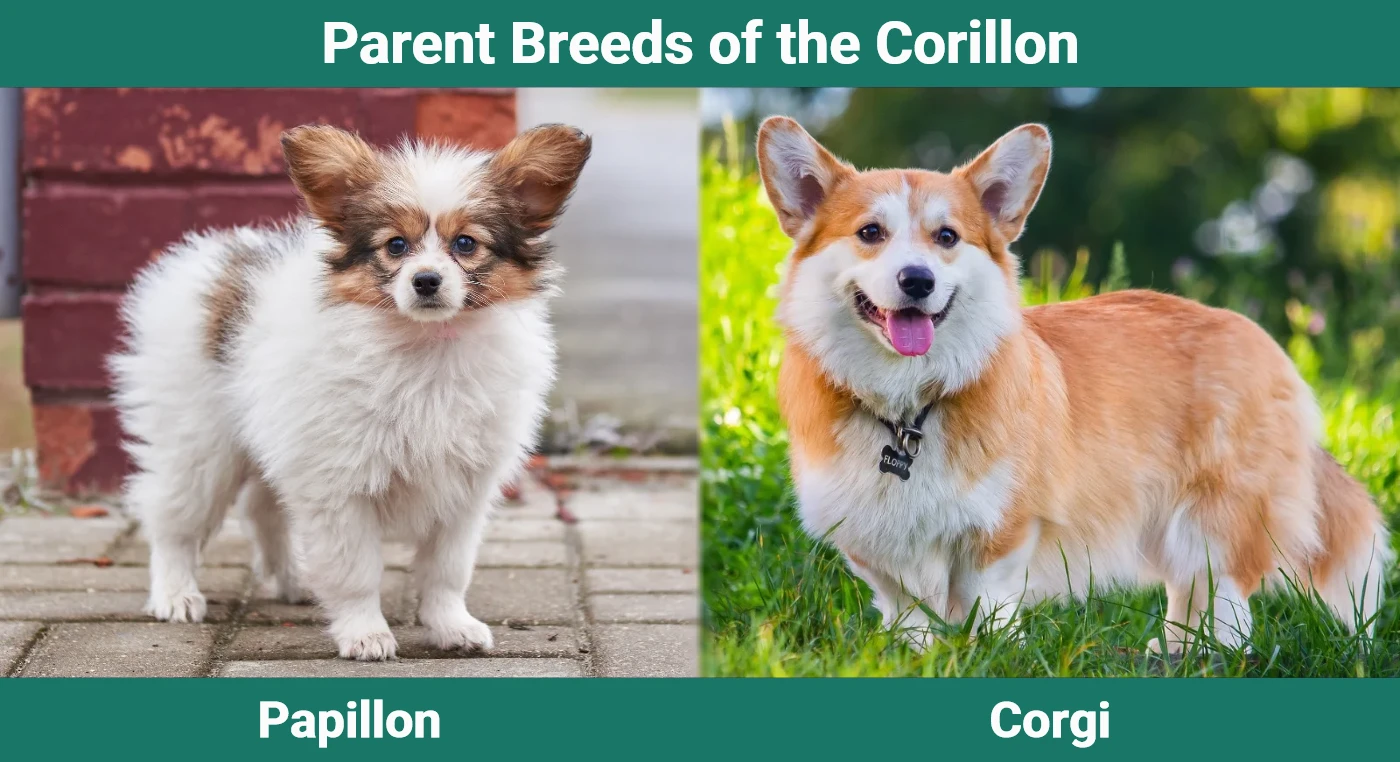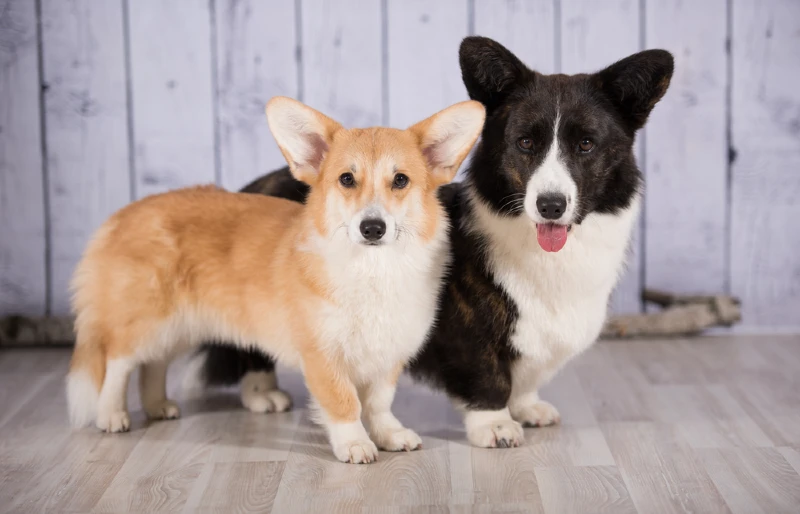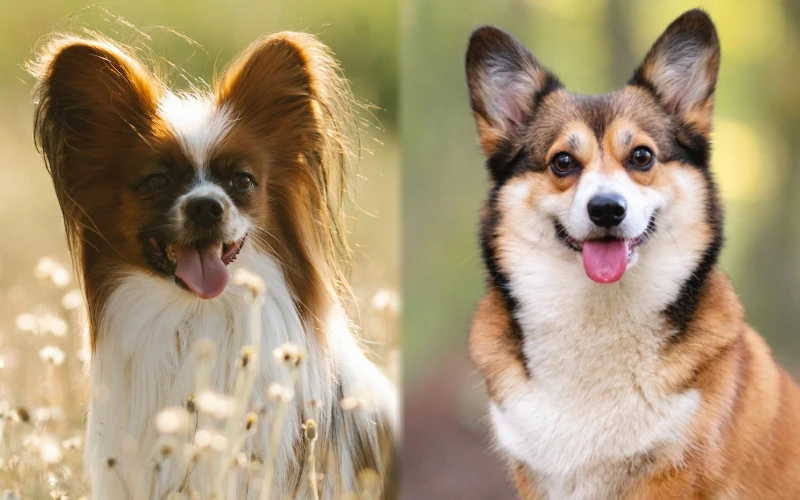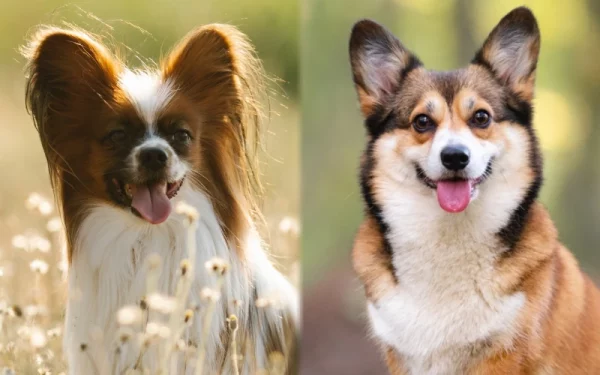Click Below to Skip Ahead
The Corillon is a mixed-breed dog with a Pembroke Welsh Corgi parent and a Papillon parent. Small in stature but big in heart, the Corillon is a combination of two breeds known for being plucky, cheerful, sociable, and athletic. What’s more, behind the Corillon is a long and intriguing history, as the parent breeds have graced us with their presence for many, many years.
Breed Overview
Height:
8–12 inches
Weight:
15–25 pounds
Lifespan:
12–16 years
Colors:
Black & tan, fawn, red, sable, white & black, white & lemon, white & red, white & sable, white black & tan, black brown & white (more colors may be possible)
Suitable for:
Active and loving families
Temperament:
Upbeat, friendly, athletic, affectionate, alert
The Corillon can come in a number of color combinations because of the diverse color possibilities of the parent breeds. White markings or markings in other colors are also possible. This spunky little dog merges two sets of unique physical features, two of which are the infamous butterfly ears of the Papillon and the long, rounded, stocky Pembroke Welsh Corgi build. Traits may vary, though, since this is a mixed breed, meaning anything is possible!
Corillon Characteristics

Corillon Puppies
Since they’re pretty athletic as adults, Corillon puppies are sure to be little livewires, so be prepared to try and keep up with them! Puppyhood is a critical time for training and socializing dogs, as they internalize what they learn much more easily, so it’s best to get started on that as soon as your new dog comes home. Adult dogs can also be trained and socialized, but it may take a little more time.
As for how to acquire Corillon puppies, the options are getting one from as reputable a breeder as possible or adopting one. We would always say go for the second option, if possible, as shelters are jam-packed with both adult dogs and puppies. Most are mixed breeds, and you might be surprised at the diversity in shelters.
Of course, there’s no guarantee you’ll find a Corillon specifically, but it’s worth giving it a shot. Even if you don’t, you might fall for another cutie that you’d love to bring home. If you opt to go via a breeder, steer clear of backyard breeders and breeders that don’t carry out health checks or take care of the animals’ welfare.
Unscrupulous breeders are likely to push you into making a decision so they get paid quickly (some even give the puppies away before they’re 8 weeks old) or may be reluctant to let you visit the mother and other puppies. Watch out for these giveaway signs of an unscrupulous breeder.

Temperament & Intelligence of the Corillon
Are These Dogs Good for Families?
Whether a dog makes a good member of the family comes down to how dedicated you are to socializing them. Socialization ensures that the dog grows up to be comfortable around all different types of dogs and people in addition to the family.
Well-raised Papillons and Corgis are both wonderful family dogs known for possessing merry and playful dispositions and also for thriving on love and attention from family members, so don’t be surprised if your Corillon matches this description.
One thing to bear in mind is that Corgis were bred for herding, and herding dogs are famous for not losing the urge to herd other animals and people in the house. If your Corillon shows signs of having inherited this trait from their Corgi parent, you’ll need to consistently reinforce commands like “leave it” and “watch me” to ensure your bossy Corillon develops a good sense of impulse control and focus.
Does the Corillon Get Along with Other Pets?
With adequate socialization and proper introductions, the Corillon should have no problem getting along with other cats, dogs, and maybe even rabbits in the house.
It’s best to introduce your new dog to other animals in your home slowly and under close supervision. Create positive associations for both your new dog and your other pets (treats and gentle encouragement can help with this) and avoid letting your Corillon herd their new companions if you want peace to reign!

Things to Know When Owning a Corillon
Food & Diet Requirements
Your Corillon will need food formulated for the life stage they’re at (puppy, adult), and it should be labeled “complete and balanced”. This means that it can fulfill all your dog’s nutritional needs.
If you want to make things more interesting for your pooch, you can offer complementary dog foods or feed safe human foods (certain fruits and vegetables, boiled eggs, bits of lean, cooked meat, etc.) as supplements to your Corillon’s normal diet. Don’t go overboard on the treats, though, as this could lead to a “weighty” problem.
The Papillon is a toy breed, whereas Pembroke Welsh Corgis fall into the small-to-medium dog category. If you choose to feed a size-specific formula, check your dog’s weight against the recommendation on the packaging to find out if it’s suitable for your Corillon’s size. Alternatively, you can ask your vet for advice if you’re not sure.
Exercise
As small but active and athletic dogs, Corillons need a moderate amount of daily exercise. Each dog has individual exercise needs, but, as an estimate, Corillons will need around 45 minutes of exercise per day. Daily walks are essential, but you can provide extra exercise opportunities at home with games like tug of war and fetch.
If your Corillon’s body type is more similar to a Papillon’s than a Corgi’s, be cautious when playing with them: Since they’re so small, Papillons are fragile dogs that can easily be hurt by a fall or too-rough play. The Corgi blend may help balance this out, though, as Corgis are pretty sturdy dogs.
Training
Luckily, Pembroke Welsh Corgis and Papillons are very trainable dogs thanks to their high intelligence and eager-to-please personalities. However, based on generalizations about the parent breeds, you may face a couple of challenges when training a Corillon.
Papillons, for instance, sometimes need special focus on learning to be comfortable spending a certain amount of time alone because they have a tendency to become deeply attached to their people. They were originally bred as companion dogs, so can be sensitive to being left alone. Build up the time your dog spends alone in small increments and always make it a positive experience for them.
On the other hand, Corgis are sometimes said to possess a stubborn streak. If your Corillon inherits this, they’ll need a kind but firm hand (this does not mean physical punishment) to guide them through the training process. Always use positive reinforcement instead of taking a harsh approach.
Grooming ✂️
Your Corillon’s grooming needs will depend on the type of coat they inherit. Papillons have silky, single coats that don’t shed much, but they can become tangled and matted, especially behind the ears, under the legs, and on the thighs. To combat this if your Corillon inherits this coat type, you can go over them regularly with a brush and comb, paying particular attention to the areas mentioned.
The Corgi’s coat is a little different, as these dogs have double coats that shed moderately. If your Corillon has a double coat, you can get rid of loose hairs by brushing daily, and up the ante with a de-shedding tool in spring and fall when they shed more heavily.
Your Corillon will need to have their nails trimmed if they’re looking a little too long. In addition, look inside the ears on a regular basis to check for signs of infection or general dirtiness, and clean them with a dog-friendly solution if necessary. Daily tooth brushing is also recommended.
Health and Conditions
Corgis and Papillons generally enjoy good health and have long lifespans as long as they’re cared for well. There are some conditions that can affect them, however. Corgis have been linked to heart conditions, eye conditions, hip dysplasia, and von Willebrand’s disease (a bleeding disorder). Papillons sometimes inherit an open fontanelle (a skull condition), and patella luxation (a knee condition).
- Minor skin conditions that receive treatment
- Bone conditions
- Hip dysplasia
- Von Willebrand’s disease
- Eye conditions
- Heart conditions
Male vs Female
In terms of personality, there are no cast-iron differences between male and female dogs. Each dog has their own individual character, and their behavior is shaped by their background, socialization, and training. Some believe that male dogs are more affectionate while females are more independent and easier to train, but personality types among dogs are diverse and unique.
If your dog is unspayed (female) or unneutered (male), you’re more likely to notice behavioral differences. Unneutered males can be more territorial and become prone to roaming and fighting with other dogs, while unspayed females can experience mood swings, urinate more, and engage in self-grooming behavior more often. They also become more flirtatious than usual. These behaviors are all related to hormones.
3 Little-Known Facts About the Corillon
1. Pembroke Welsh Corgis Are the Stuff of Legends
According to legend, the Pembroke Welsh Corgi once worked as a coach-puller for fairies and elves. The markings on their shoulders are sometimes referred to as “fairy saddles”.
2. “Papillon” Has a Special Meaning
“Papillon” means “butterfly” in French, and is a reference to the breed’s large, butterfly-like ears. Papillons with dropped-down ears are called “Phalène”, which means “moth”, in Europe.
3. There Are Two Corgi Types
The Pembroke Welsh Corgi and the Cardigan Welsh Corgi are the two Corgi types, and they’re different breeds altogether. The Cardigan dates back thousands of years, whereas the Pembroke is believed to date back to 1107 AD.


Conclusion
The Corillon is a truly intriguing mixed breed in a number of ways, and there are plenty of fascinating facts to learn about the history of the parent breeds. If you’re set on getting your own big-eared, smiley companion, then we recommend checking out local shelters before buying one, as you could just be pleasantly surprised by who you find there.
Some organizations focus specifically on Corgis, Papillons, and mixes of these breeds, so these would be a good place to start.
Featured Image Credit: Left – Blue Bird, Pexels | Right – Jus_Ol, Shutterstock











